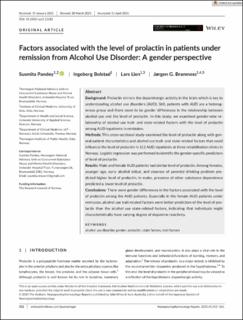Factors associated with the level of prolactin in patients under remission from Alcohol Use Disorder: A gender perspective
Peer reviewed, Journal article
Published version

Permanent lenke
https://hdl.handle.net/11250/2996563Utgivelsesdato
2021Metadata
Vis full innførselSamlinger
- Artikler [5063]
- Publikasjoner fra CRIStin FHI [7538]
Sammendrag
Background: Prolactin mirrors the dopaminergic activity in the brain which is key to understanding alcohol use disorders (AUD). Still, patients with AUD are a heterogenous group and there seem to be gender differences in the relationship between alcohol use and the level of prolactin. In this study, we examined gender-wise relationship of alcohol use trait- and state-related factors with the level of prolactin among AUD inpatients in remission. Methods: This cross-sectional study examined the level of prolactin along with general patient characteristics and alcohol use trait- and state-related factors that could influence the level of prolactin in 112 AUD inpatients at three rehabilitation clinics in Norway. Logistic regression was performed to identify the gender-specific predictors of level of prolactin. Results: Male and female AUD patients had similar level of prolactin. Among females, younger age, early alcohol debut, and absence of parental drinking problem predicted higher level of prolactin. In males, presence of other substance dependence predicted a lower level of prolactin. Conclusions: There were gender differences in the factors associated with the level of prolactin among the AUD patients. Especially in the female AUD patients under remission, alcohol use trait-related factors were better predictors of the level of prolactin than the alcohol use state-related factors, indicating that individuals might characteristically have varying degree of dopamine reactivity. Keywords: alcohol use disorder; gender; prolactin; state factors; trait factors. © 2021 The Authors. Neuropsychopharmacology Reports published by John Wiley & Sons Australia, Ltd on behalf of the Japanese Society of Neuropsychopharmacology.